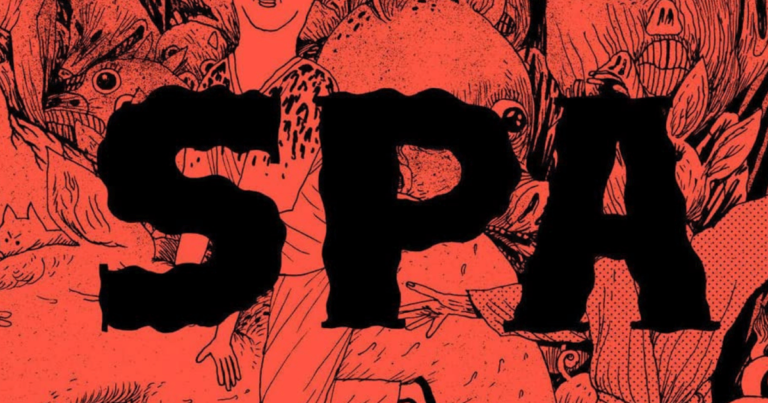Eric Svetoft’s Spa
Writer/Artist: Eric Svetoft
Translated by Melissa Bowers
Publisher: Fantagraphics Books
Publication date: February 2023
I have nightmares. Not clinically frequent, but I do get them often, so I’m trying to reduce their frequency. I don’t have caffeine or spicy food before bed, and I never watch horror movies after the sun goes down. I can’t say that my no caffeine or spicy food habits have worked for me, but I’ve been avoiding horror movies at night for years. Reading doesn’t bother me, though. Manga seems to be a visual thing that induces nightmares, too. But I can keep reading Junji Ito’s works and reprints of Tales of the Crypt late into the night. After reading Eric Svetoft’s Spa, translated by Melissa Bowers from Swedish, it was the first book that gave me nightmares.
I don’t want to oversell this, especially to voracious horror readers. I’m easily scared, and things frighten me. I jump if a kid comes around a corner too fast. So don’t run over to Svetoft to see the scariest thing you’ve ever seen; this is not that book. Rather, what really scared me about this book, and haunted my dreams, was the way Svetoft combined absolute terror with the visuals and the indifference of his characters.
The book’s art starts off cartoonish, but as the spa gets weirder and weirder, you’re soon drawn into the creepy world. From the very first image, a smiling character stares right at the reader. This in itself is not an uncommon strategy; many comics and movies have characters stare right at the reader, drawing us in and enticing us to get more involved in the thrills and action. Different creators do this to different degrees, but usually by breaking the fourth wall or by making the reader stand in for another character/place/villain/hero/being/thing.
In the spa, we often don’t know what the characters are looking at. This first image is a clear exception because it introduces a goofy-faced monster that pushes the argument for the universality of smiley faces to its limit, right at the other end of the character’s gaze. Or is it? By the third panel, the monsters encircle the characters’ bodies, and thus their gaze, making the reader the center. So before the first two pages are over, the reader is stared at, comfortable in the belief that it is these monsters that are staring, and left wondering whether the characters are staring at another monster, or at the reader. Maybe both.
This eerie gaze that Svetoft imposes on many of the characters continues throughout the first half of the book. Before we reach the titular spa, the dead are watching us. Once we get there, the residents are watching us in footage from the welcome video. Then, as the frames lead us through the different spaces of the spa itself, more characters make eye contact. Eyes are always watching the reader. They are always peering through the page we are sitting on. They don’t let go of the reader until we turn the page and new eyes appear to do the same. There is no escape.
In a film, there would be a character who stands in for the gazed-at viewer. The horror is in making that character uncomfortable, and therefore us uncomfortable. But the beauty of Svetoft’s work being a comic is that there is no substitute. Maybe some of us would invent a substitute, or assume that one of the characters is feeling the gaze. It can’t be us. It’s not us. But it is clearly us. This strategy draws the reader in in a way that is unique to comics, and maybe some arthouse films. There is horror here, but it’s not the kind that jumps out at you from around a corner. It’s the kind that lurks beneath the surface and seeps in when you least expect it. When a shadow moves unexpectedly. When you find an earworm in the place where you just killed one. When mold suddenly grows in the night.
Halfway through the book, the horror of the images becomes more concrete. The mold within the spa itself, or the herd of pigs coming around the corner, are surreal and strange, but almost blackly comedic. Nothing compares to the terror of the eyes. It’s not just the blank stare that intrigued me, it’s the connection to the rules of the universe that Svetoft has created. This world is so close to ours, and yet two places off to the left. Just on the periphery. Not far enough to be comfortably unreal, but far enough that it feels possible.
I wish I could tell you “what happens,” but that’s not what this book is about. The back cover gives a good synopsis: a wealthy spa is increasingly infected with mold and eventually collapses. And that’s really all there is to it. Don’t let the simplicity of the story scare you away; it’s the simplicity of the events and the lack of confusing details that gives it away. Lean into that and you’ll enjoy it more.
Whether it’s the director finding strange and cute creatures in every painting, the two plumbers failing to solve a problem and potentially making it worse, the man wearing a pig’s nose as punishment, or the chef taking over the lives of his wealthy customers, this book is bound to be hilariously funny. It doesn’t shy away from making deeply satirical comments about the wealthy and the industries that have sprung up to satisfy them. You’ll soon see that the characters’ banality is part of their indifference to what really matters; they have a genuine belief that they are untouchable. There is a slight linearity to events, but once Svetoft’s fangs emerge, you’re drawn into the path, no matter how much the characters make you dizzy or stomach-churning.
The book’s surrealism is complex, layered, and satirical. Nothing here is super obvious. It respects the reader’s ability to follow the story and find the comedy (the centipede monster kisses the director lightly) in the absurdity (a man can’t find his way into a room, even though it is there). There’s no holding you back, just unfolding events that seem objectively observed.
This is where the horror really hits. Sure, your gaze lingers long after you put the book down, but so do the events. The body is disposed of easily, the conference room is littered with corpses, and no one mentions the harpoon-wielding customer. It’s as normal as a front desk clerk fighting with his sister and then getting yelled at by HR for taking a personal phone call. It’s all surreal, and all too real. Like the book, this doesn’t make much sense, but does anything in this world make sense anymore? Honestly, a herd of pigs riding horses through a moldy spa sounds like a Tuesday news story with seven pages of real-world absurdism.
This comic doesn’t hold back. It criticizes, it satirizes, it makes fun of. It scares. It feels real. And it’s a lot of fun. You can tell from every image, every line, every design that Eric Svetoft is having so much fun. You feel the image of things blowing up and pure euphoria at the same time. If you want to let yourself get sucked into that world, you couldn’t ask for a better guide than Svetoft. What he wants to show you is horrifying and terrifying, but you can’t help but laugh. You have to laugh your head off as you go to sleep, muttering “what the hell” into your pillow. Only in your nightmares is it all starting to make sense.
Read more great reviews from The Beat!
Like this:
Like Loading…


